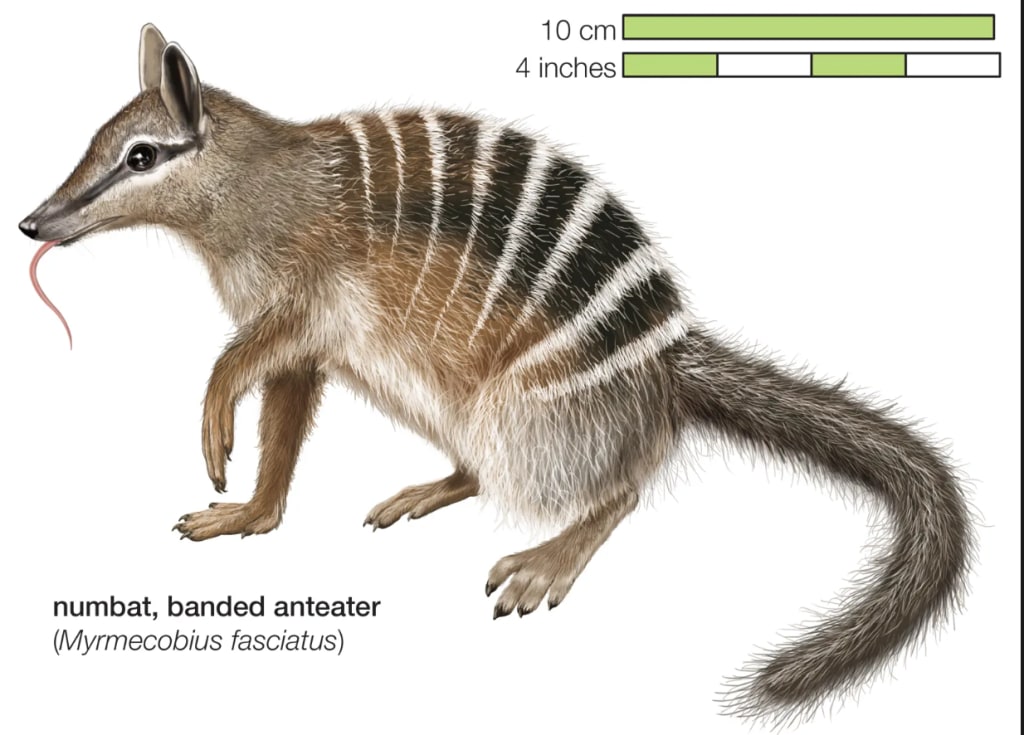The Numbat: Australia's Striped Anteater
Numbat

Introduction:
In the vast and diverse landscape of Australian wildlife, one remarkable creature often escapes the limelight despite its unique characteristics and ecological importance - the Numbat (Myrmecobius fasciatus). Often referred to as the "banded anteater," the Numbat holds a special place in Australia's biodiversity. In this blog, we will delve into the captivating world of Numbats, exploring their habitat, behavior, diet, conservation status, and the significance of preserving this species.
Taxonomy and Evolution:
The Numbat belongs to the family Myrmecobiidae, and it is the only member of its genus, Myrmecobius. This marsupial has a lineage that traces back millions of years, making it a living relic of Australia's evolutionary history.
Distinctive Physical Features:
The Numbat is easily recognized by its striking appearance. Covered in reddish-brown fur, it boasts a series of white stripes across its back and a pointed face reminiscent of an anteater. Despite having a similar appearance, Numbats are not closely related to true anteaters, showcasing the fascinating phenomenon of convergent evolution.
Habitat and Distribution:
Numbats are primarily found in eucalypt woodlands and dry sclerophyll forests of Western Australia. Historically, their range extended to the eastern and southern parts of Australia, but habitat loss has confined them to the southwestern regions.
Diurnal Lifestyle and Termites:
Unlike many other marsupials, Numbats are diurnal, meaning they are active during the day. Their primary diet consists of termites, and they have a specialized long, sticky tongue that aids in extracting these insects from narrow crevices in logs and soil.
Marsupial Reproduction:
Female Numbats have a unique reproductive system, with a backward-facing pouch to protect their young from soil when digging for termites. They give birth to relatively undeveloped young, called joeys, which continue their development within the pouch.
Endangered Status:
The Numbat faces severe threats to its survival, primarily due to habitat destruction and introduced predators like foxes and feral cats. As a result, the species is listed as endangered, highlighting the urgent need for conservation efforts to prevent its decline.
Conservation Initiatives:
Various conservation organizations and researchers are actively involved in projects aimed at preserving the Numbat population. Habitat restoration, predator control programs, and captive breeding initiatives are crucial components of these efforts.
The Role of Numbats in Ecosystems:
Numbats play a vital role in maintaining ecological balance by controlling termite populations. As insectivores, they contribute to pest control, benefiting both the natural environment and nearby agricultural lands.
Cultural Significance:
Indigenous Australian cultures hold the Numbat in high regard, featuring the species in their stories and artwork. Understanding and respecting the cultural significance of the Numbat is essential for fostering a holistic approach to its conservation.
Ecotourism Opportunities:
Promoting responsible ecotourism can contribute to Numbat conservation. Guided tours that educate visitors about the species, its habitat, and the challenges it faces can generate awareness and support for ongoing conservation initiatives.
The Importance of Public Awareness:
Raising awareness about the Numbat's plight is crucial for garnering support from the public and policymakers. Education campaigns, documentaries, and social media initiatives can help disseminate information about this unique marsupial.
International Collaboration:
Given the global nature of conservation challenges, international collaboration is vital. Sharing knowledge, resources, and expertise can enhance the effectiveness of conservation measures and contribute to the overall well-being of the Numbat population.
Conclusion:
In conclusion, the Numbat stands as a testament to Australia's rich biodiversity, showcasing the intricate web of life that exists on the continent. As an endangered species, the Numbat requires concerted efforts from scientists, conservationists, policymakers, and the public to ensure its survival. By understanding and appreciating the significance of this remarkable marsupial, we can collectively work towards a future where the Numbat thrives in its natural habitat, contributing to the ecological balance of Australia's unique ecosystems.
About the Creator
Enjoyed the story? Support the Creator.
Subscribe for free to receive all their stories in your feed. You could also pledge your support or give them a one-off tip, letting them know you appreciate their work.






Comments
There are no comments for this story
Be the first to respond and start the conversation.